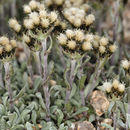Comments
provided by eFloras
Antennaria pulchella is the diploid progenitor of A. media and, consequently, a progenitor of the A. alpina complex (R. J. Bayer 1990d). The A. rosea and A. parvifolia complexes also have the genome of A. pulchella, shown in the high elevation clones with dark phyllaries in these two polyploid complexes. Antennaria pulchella is differentiated from A. media by shorter pistillate or staminate corollas and shorter cauline leaves (Bayer). This sexually reproducing diploid ranges from the area around Lake Tahoe to the Mt. Whitney region (Bayer).
- license
- cc-by-nc-sa-3.0
- copyright
- Missouri Botanical Garden, 4344 Shaw Boulevard, St. Louis, MO, 63110 USA
Description
provided by eFloras
Dioecious. Plants (1–)3–12 cm (stems usually stipitate-glandular). Stolons 1–4(–9) cm. Basal leaves 1-nerved, spatulate to linear-cuneate, 6–12 × 1.5–4.5 mm, tips mucronate, faces glabrescent-scabrous to gray-pubescent (often with purple glandular hairs). Cauline leaves linear, 3–11(–13) mm, usually not flagged (apices acute to acuminate), rarely distal flagged. Heads 4–6 in corymbiform arrays. Involucres: staminate 4–5 mm; pistillate 3.5–4.5 mm. Phyllaries (relatively wide) distally dark brown-black (sometimes light brown or whitish at very tips; apices blunt). Corollas: staminate 1.9–2.8 mm; pistillate 2–3 mm. Cypselae 0.7–1.3 mm, glabrous or slightly papillate; pappi: staminate 2.5–3.5 mm; pistillate 2.5–3.5 mm. 2n = 28 (as A. media).
- license
- cc-by-nc-sa-3.0
- copyright
- Missouri Botanical Garden, 4344 Shaw Boulevard, St. Louis, MO, 63110 USA
Synonym
provided by eFloras
Antennaria alpina (Linnaeus) Gaertner var. scabra (Greene) Jepson; A. media Greene subsp. ciliata E. E. Nelson; A. media subsp. pulchella (Greene) Chmielewski; A. scabra Greene
- license
- cc-by-nc-sa-3.0
- copyright
- Missouri Botanical Garden, 4344 Shaw Boulevard, St. Louis, MO, 63110 USA

